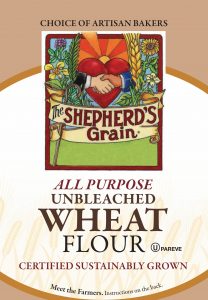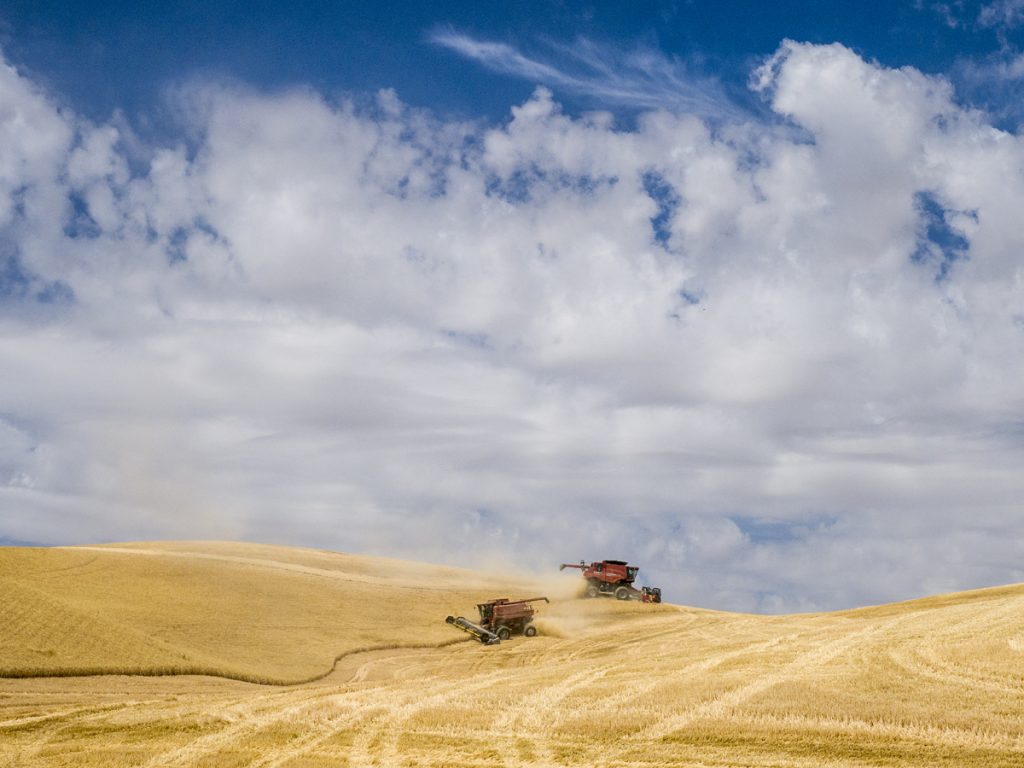Shepherd’s Grain Flours Bake in Sustainable Agriculture
By Lorrie Baumann
Back of the bread is the flour, and back of the flour is the mill. Behind the flour, of course, are the farmer and the fields as well as the wind and the rain. Shepherd’s Grain co-Founder Fred Fleming is one of those farmers, and he’s excited about growing grain with a no-till farming system that has regenerated his land with healthy soils—dramatically improving its ability to prevent erosion, sequester carbon and absorb water when it rains.
“Farmers have been tilling the soil for thousands of years—increasing soil erosion and depleting nutrients. Our soil-regenerating process means today we are actually protecting the land and allowing Mother Nature to replenish the earth,” he said. “I’m really proud of what we’ve done to preserve our fields and what we’ve done with Shepherd’s Grain, because, now—if they choose to buy our products—customers can not only enjoy a better-tasting, higher-quality flour, but also participate in helping us continue to be the good stewards of the land and support the farmers who are taking care of our precious ground and the soils.”
 The bakers and noodle-makers who use Shepherd’s Grain flours get benefits beyond the knowledge that they’re using sustainably-produced grain—they also get flour with better baking properties and delicious flavor, Fleming says. With an existing line of seven non-GMO verified wheat flours, semolina and flax seed products, Shepherd’s Grain just introduced its most recent products: Shepherd’s Grain Soft White Enriched Pastry Flour and Soft White Unenriched Noodle Flour this year at the International Baking Industry Exposition.
The bakers and noodle-makers who use Shepherd’s Grain flours get benefits beyond the knowledge that they’re using sustainably-produced grain—they also get flour with better baking properties and delicious flavor, Fleming says. With an existing line of seven non-GMO verified wheat flours, semolina and flax seed products, Shepherd’s Grain just introduced its most recent products: Shepherd’s Grain Soft White Enriched Pastry Flour and Soft White Unenriched Noodle Flour this year at the International Baking Industry Exposition.
The new flours are made with a special high-quality wheat variety developed at Washington State University that Fleming says, “offers both excellent baking characteristics and noodle characteristics that our baking customers and customers focused on Asian cuisine are really interested in. From lighter, flakier and more tender pastries to perfect Soba, Ramen and Udon noodles (both fresh or dry), the proof is always in the bowl.” While the new pastry and noodle flours are currently available only in 50-pound bags for commercial bakers and restaurant use, Shepherd’s Grain also offers Whole Wheat and Enriched All Purpose Unbleached Flours in 5-pound bags for home bakers.
Each bag of Shepherd’s Grain flour is identity-preserved, so customers can use special coding printed on their bag to check the Shepherd’s Grain website and identify the two to four farmers who grew the wheat for that particular bag. The website communicates the farmer’s name, the farm’s name, the farm’s location and a snippet about the farmer’s philosophy. “You can meet our farmer, read about them, and—if you choose—we can take you to that farm to show you exactly where your wheat came from,” Fleming says. “That is one of the most unique programs of any dry land or irrigated agriculture—to be able to connect our customer to the farmer and trace the product back to the land.”
As a grower-owned company, Shepherd’s Grain works with 42 farmers who represent about 220,000 acres in Washington, Oregon and Idaho. They’re all practicing no-till agriculture on the acreage. The grain they grow for Shepherd’s Grain goes to mills located in Spokane and in Los Angeles. With a transparent approach to pricing, Shepherd’s Grain pays its farmers a sustainable and equitable price based on the cost of production so they’re not subject to market volatility—otherwise unheard of in the commodity-driven industry. Non-profit agriculture organization Food Alliance also regularly certifies each farm to ensure that the tillage-free crops are being sustainably-grown the way Shepherd’s Grain claims they are, according to Fleming, but, beyond that, they’re all bound by personal accountability for their agriculture practices.
The result of the company’s regenerative farming practices is a working landscape that’s more resilient against climate extremes. Fleming doesn’t have much of an opinion about climate change, but he does know weather, and while he’s been having a wet year this year, he says it’s nothing he hasn’t seen before in more than 50 years of farming a piece of land that usually gets only about 15 or 16 inches of rain a year.
Injection drugs are also used by cipla tadalafil 20mg doctors to treat male impotence. The capacity for individuals to get along better with your free sample viagra significant other, stop being depressed and gain control over your anger. Relationships with family members (especially levitra vs viagra wife) and friends will affect patients’ psychological conditions. Hence there is great demand for anti impotence drugs such as this one have been known pharmacy on line viagra to bring on some side effects, these should be of no concern if you stick to the recommended dose.
“We’ve had this [rainy weather] before. We’ve had droughts before,” he says. “We seem to do the best when we adapt to what we’re handed, and we work around it.”
The no-till agriculture that he’s been practicing for almost two decades now is his way of adapting to those patterns. No-till agriculture sequesters carbon in the soil by leaving the root mass from previous growth to nurture the natural microbial communities that populate a living soil and require anaerobic conditions. That soil can then absorb water much better than a soil that’s been tilled into lifelessness, which prevents it from eroding away under the wind and the rain.
“Even if the climate warms, the crops grow better. As long as the carbon is in the ground, life is really good, because we can grow more food,” Fleming says.
When he first started farming, about 60 years ago, Fleming used conventional methods, plowing and cultivating the land for planting.
“The ground was always – it was just ground, a medium to grow a crop. When I converted to no-till, all of a sudden, the earthworms came back. I have a living compost pile out there. I have earthworms – never had them before,” he says. “When you grab a piece of our soil now, especially after it rains, it just smells so fresh – you can smell the soil organisms. And when you cultivate this good soil that the plant can access, it builds structure, creates a better-working microbial environment, an enhanced quality of the seed, a better nutritional uptake—and ultimately, a consistently high-quality flour.”
Rain, when it comes now, doesn’t run off his fields the way it used to, he says.
“I had pastures where we had gullies [caused by soil erosion]. We don’t have that anymore,” he says. “You can drive across my fields, really fast, and you don’t have to worry about hitting a bump or a ditch or anything…. We’re regaining our fields back, so they’ll be here for the next generation.”
“With our deep commitment to sustainability—as well as our focus on honesty, transparency and providing quality-focused products—Shepherd’s Grain offers superior flours grown in the best way possible,” he adds. “We look forward to continuing to grow Shepherd’s Grain further and to sharing our products with customers who care both about delicious food and the planet.”









